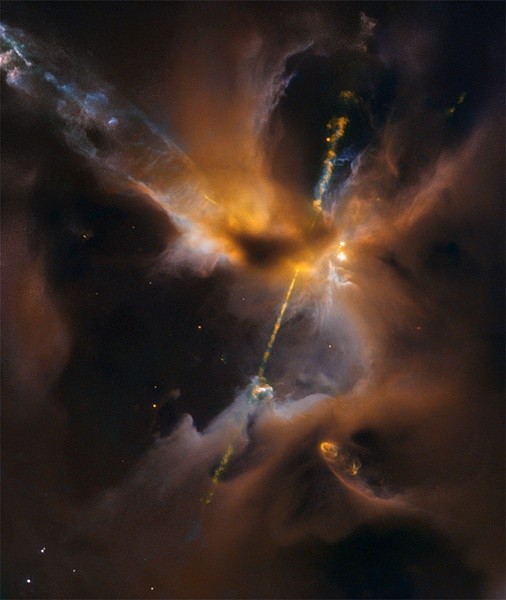[PHOTO] Cosmic Lightsaber? Protostar Explodes With Powerful Jets
| Ana Verayo | | Dec 18, 2015 07:24 AM EST |
(Photo : ESA/Hubble & NASA, D. Padgett (GSFC), T. Megeath (University of Toledo), and B. Reipurth (University of Hawaii)) The two lightsaber-like streams crossing the image are jets of energised gas, ejected from the poles of a young star. If the jets collide with the surrounding gas and dust they can clear vast spaces, and create curved shock waves, seen as knotted clumps called Herbig-Haro objects.
A cosmic "lightsaber" was seen piercing through dark clouds of dust and that could be mistaken as a scene from the new Star Wars movie, only this time, NASA's Hubble Space Telescope captured this stunning new image.
Like Us on Facebook
These two beams of light are produced from fallout material from a newly born star where they shoot outwards in opposite directions at supersonic speeds, creating two jets similar to the lightsaber wielded by Darth Maul.
This cosmic collapse of heavy clouds and dust around gas falls inward, where dust and gas are spiralling around a protostar that will eventually grow into a colossal size from fusion. Other cases show how this star material can stream out of young stars which suddenly causes an eruption of fiery jets, bursting out on its stellar poles.
These powerful jets now collide and combine with the cosmic material surrounding it, that create shock waves from their ends. These will then give birth to tangled and knotted star material in bunches known as Herbig-Haro (HH) objects, according to the European Space Agency.
This "cosmic lightsaber" or rather, this HH object in this new Hubble image that surrounds this young star is called HH24. ESA scientists say that these supersonic shockwaves heat up the surrounding gas reaching up to thousands of degrees Fahrenheit.
Prior research also reveals how these double jets that are emitted from this cosmic lightsaber are apparently just short bursts, spanning less than a quarter of a light year or 1.34 trilion miles long from each end. These jets also share a much closer interaction with its surrounding region in space as opposed to similar cosmic objects suggesting that the age of these jets are only about a few thousand years old which is relatively new.
This object is apparently located within the Milky Way galaxy, bursting into life some 1,350 light years away from the Orion constellation. ESA scientists also say that there are also smaller jets that are so faint in this image, emanating from more newborn stars where this makes it the densest concentration of HH jets in a small region in space.
Tagscosmic lightsaber, NASA hubble space telescope, protostar explosion jets, newborn star hubble, NASA, ESA, HH objects, HH 24
©2015 Chinatopix All rights reserved. Do not reproduce without permission
EDITOR'S PICKS
-

Did the Trump administration just announce plans for a trade war with ‘hostile’ China and Russia?
-

US Senate passes Taiwan travel bill slammed by China
-

As Yan Sihong’s family grieves, here are other Chinese students who went missing abroad. Some have never been found
-

Beijing blasts Western critics who ‘smear China’ with the term sharp power
-

China Envoy Seeks to Defuse Tensions With U.S. as a Trade War Brews
-

Singapore's Deputy PM Provides Bitcoin Vote of Confidence Amid China's Blanket Bans
-

China warns investors over risks in overseas virtual currency trading
-

Chinese government most trustworthy: survey
-

Kashima Antlers On Course For Back-To-Back Titles
MOST POPULAR
LATEST NEWS
Zhou Yongkang: China's Former Security Chief Sentenced to Life in Prison

China's former Chief of the Ministry of Public Security, Zhou Yongkang, has been given a life sentence after he was found guilty of abusing his office, bribery and deliberately ... Full Article
TRENDING STORY

China Pork Prices Expected to Stabilize As The Supplies Recover

Elephone P9000 Smartphone is now on Sale on Amazon India

There's a Big Chance Cliffhangers Won't Still Be Resolved When Grey's Anatomy Season 13 Returns

Supreme Court Ruled on Samsung vs Apple Dispute for Patent Infringement

Microsoft Surface Pro 5 Rumors and Release Date: What is the Latest?










